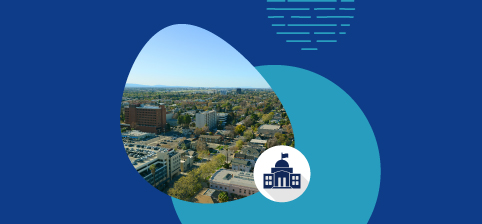The world of data analytics is changing faster than ever. And government employees have to keep up or get left in the dust. By 2024, 60% of government data analytics and artificial intelligence (AI) projects are predicted to directly impact real-time operational decisions and outcomes. As public servants, you need to increase your literacy of the larger data ecosystem to do your jobs efficiently and effectively. This guide will help you learn four key competencies inspired by that lifecycle so you can enhance everyday collaboration and bring continuous improvement to your team and agency. The four key competencies are data visualization, data storytelling, automation and innovation. With the help of experts who do this work every day, here are best practices to help you better use and share data at work. According to the Federal Data Strategy 2021 Action Plan, “By the end of 2022, agencies should have a solid foundation throughout their workforce, including a minimum level of data literacy among all staff and a sufficient accumulation of data skills to allow for effective performance of all aspects of the data lifecycle.” Download the guide to learn how to reach these goals with the four key competencies.
Data Literacy for Government Transparency
“Technology has changed so much, but our skill sets haven’t kept pace. People and organizations that previously didn’t use data all that much suddenly have to start using it at a more advanced level. That’s why it’s imperative to establish a data literacy program at your agency. First, it needs to be agile. Data training cannot be a one-and-done deal. Second, have accessible assessments. Are you developing sustainable programs that meet people at the skill levels they’re at? And are you assessing the actual skills of your target audience, or the employees who are impacted by data? Third, co-design, or design solutions with users and stakeholders from the start. People can resist change especially when they are not involved in it. When you build data solutions or programs, you need the perspectives of users to inform the journey, particularly when they’re non-data experts.”
Read more insights from Tableau’s Senior Manager of Customer Success, State and Local Government, Nongovernmental Organizations (NGOs) and Higher Ed, Sarah Nell-Rodriquez.
What Story Is Your Data Telling?
“Let’s say defense analysts are trying to connect the dots around terrorist activity. Using various data points such as bank account numbers, location coordinates, equipment types and names, analysts can derive a cohesive “story” from the data that aids the mission. To do this, traditionally, analysts combed through data from various sources — spreadsheets, databases, cloud storage, etc. — to manually input into an Excel file and then make connections between the fields. ‘To get to a story or result on one particular mission-critical use case, it was taking six to nine months of two full-time employees just combing through this data,’ said MarkLogic’s Eric Putnam, who has worked in the U.S. defense community. In other words, this manual integration was taking too much time and too much effort.”
Read more insights from MarkLogic’s Senior Account Executive for National Security Programs, Eric Putnam.
How AI Opens Up Other Types of Data
 “Imagine you have a massive cache of digital family photos, and you’re looking for images of your child’s kindergarten graduation. Sure, it’s great having all those photos on the computer, but unless you tagged them in some way, there’s no quick way to find what you need. This dilemma mirrors how valuable information can be so difficult to find when it comes in the form of ‘unstructured data.’ Unstructured data includes images, video, audio and other types of information that cannot be stored in traditional databases or analyzed with traditional data tools. Structured data appears in rows and columns that are clearly labeled, making it easy to sort and analyze. Unfortunately, that’s not the case with unstructured data.”
“Imagine you have a massive cache of digital family photos, and you’re looking for images of your child’s kindergarten graduation. Sure, it’s great having all those photos on the computer, but unless you tagged them in some way, there’s no quick way to find what you need. This dilemma mirrors how valuable information can be so difficult to find when it comes in the form of ‘unstructured data.’ Unstructured data includes images, video, audio and other types of information that cannot be stored in traditional databases or analyzed with traditional data tools. Structured data appears in rows and columns that are clearly labeled, making it easy to sort and analyze. Unfortunately, that’s not the case with unstructured data.”
Read more insights from Micro Focus Government Solutions’ Senior Solution Architect for AI/ML/Data Privacy/Data Governance, Patrick Johnson.
Finding the Solution in Unexpected Places
“Democratized analytics is the technological capability that enables data workers of various technical skill levels to leverage data and share its insights with other employees of various skill levels. Put simply, it’s analytics accessible for and inclusive to all. Unified analytics is technology that allows data workers to perform the entire analytic life cycle in one place. From data prep and blend, which identifies and combines data for descriptive, predictive and prescriptive analytics, to machine learning, an advanced form of AI that gets smarter over time — unified analytics allows a range of data transformation processes to be done in a single location, no matter the data source or type. No-code/low-code analytics is analytics that does not require coding skills to prep, clean, analyze and share data. And we’re not talking spreadsheets here.”
Read more insights from Alteryx’s Director of Solutions Marketing for the Public Sector, Andy MacIsaac.
Let’s Get Back to Basics for Collaboration
“Everyday work is more than what happens at the task level. You may think updating spreadsheets and responding to emails are low-value chores, but these and countless other tactical to-dos impact how the larger mission is carried out. How task-level activities get done reflect the health and success of strategic-level goals and initiatives. However, some federal agencies are missing out on the efficiencies and insights that can be captured at the tactical level. A survey commissioned by Smartsheet, a cloud-based work management platform provider, found that 76% of government officials estimate that using collaborative work management software could increase their organization’s efficiency. However, nearly one in three federal workers today are prevented from achieving success because their teams are siloed. Federal workers need visibility and access to information if they’re expected to collaborate with others and make informed decisions.”
Read more insights from Harvard Kennedy School’s Senior Advisor for Insight Partners and Senior Fellow, Nick Sinai.
Download the full GovLoop Guide for more insights from these data literacy thought leaders and additional government interviews, historical perspectives and industry research on the future of data.






